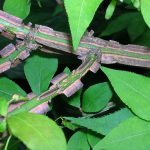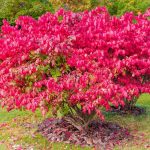Burning Bush/Winged Euonymus
Identification:
Burning bush is a deciduous shrub standing 5 to 10 feet tall with approximately the same width. Mature plants may grow up to 20 feet high. It has football-shaped, oppositely arranged, finely toothed or serrated leaves that are between one and two inches long. The leaves turn a brilliant purplish red to scarlet before dying in the fall. The easiest way to identify it are the “wings” along the branches of the shrub that are similar in appearance to cork. It has the ability to grow in deep shade under mature forests, shading out young trees.
Burning bush was introduced as a landscaping plant as early as the 1860s. This shrub can form dense thickets that can prevent native species from growing. The seeds are also well liked by various bird species and can spread to areas that are not yet affected. They are hard to control because of the large number of seed that are produced annually. The shrub was widely planted along highways and in developments for its colorful foliage in the fall.
Control:
Hand pulling is acceptable for small saplings of this species, with mechanical removal and a “cut-and-dab” chemical treatment needed for larger bushes. Before seeds show up in summer, branches can be cut and removed to limit the spread of new plants. If any cutting is done after seeds are visible, be sure to carefully bag any and all seeds to limit accidental spreading.


